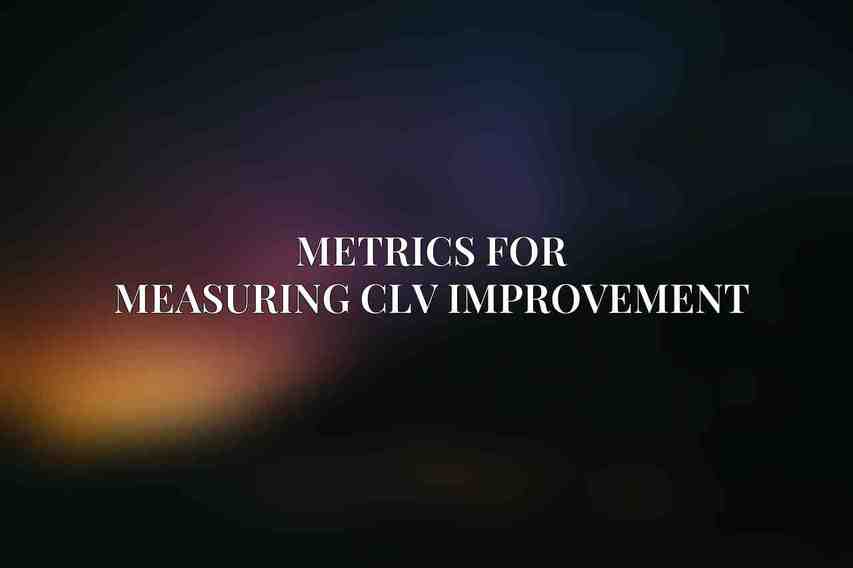Customer Lifetime Value (CLV) is a fundamental metric in e-commerce that calculates the projected revenue a customer will generate over the course of their relationship with a business. Understanding CLV is essential for e-commerce businesses to make informed decisions about marketing strategies, customer retention efforts, and overall business growth.
The Importance of CLV in E-commerce cannot be overstated. By focusing on CLV, businesses can prioritize valuable customers, tailor marketing efforts effectively, and improve customer retention strategies. Maximizing CLV leads to sustainable revenue growth and long-term success in the highly competitive e-commerce world.
Benefits of Maximizing CLV include increased profitability, improved customer satisfaction, enhanced brand loyalty, and the ability to allocate resources efficiently. By investing in increasing CLV, businesses can create a loyal customer base that consistently generates revenue and contributes to the overall success of the company.
Calculating Customer Lifetime Value
A. Average Order Value (AOV)
The Average Order Value (AOV) is a critical component in calculating CLV. AOV is calculated by dividing the total revenue by the number of orders. For example, if a customer spends $250 over 5 orders, the AOV would be $50. Read more on Leveraging Predictive Analytics to Forecast Customer Purchases in E-Commerce Read more about this on Maximizing ROI with Customer Segmentation Strategies in E-Commerce
B. Purchase Frequency (PF)
Purchase Frequency (PF) measures how often a customer makes a purchase from a business within a specific time frame. It is calculated by dividing the total number of orders by the number of unique customers. For instance, if a customer places 12 orders in a year, the PF would be 1 order per month.
C. Customer Lifespan (CLS)
Estimating the Customer Lifespan (CLS) involves predicting how long the average customer will continue purchasing from a business. Methods for estimating CLS include analyzing historical data, conducting customer surveys, and tracking customer behavior. For example, if the average customer retention period is 3 years, the CLS would be 3 years.
D. Discount Rate (DR)
The Discount Rate (DR) is used to discount future cash flows to their present value. It accounts for the time value of money and the risk associated with future revenue. Common discount rates used in e-commerce range from 8% to 12% depending on the business and industry.
E. CLV Formula and Calculation
The formula for Customer Lifetime Value is calculated as follows:
CLV = (AOV x PF x CLS) / (1 + DR)^CLS
For instance, if we have an AOV of $50, a PF of 4 orders per year, a CLS of 3 years, and a DR of 10%, the CLV would be calculated as: ($50 x 4 x 3) / (1 + 0.1)^3 = $621.
Strategies to Increase Customer Lifetime Value
Strategies to Increase Customer Lifetime Value are essential for e-commerce businesses looking to grow sustainably and build long-lasting relationships with their customers.
A. Enhance Customer Acquisition
- Targeted marketing campaigns: Tailoring marketing strategies to specific customer segments can increase customer engagement and lead to higher CLV.
- Referral programs: Encouraging satisfied customers to refer friends and family can expand the customer base and drive CLV.
- Optimizing website UX: Providing a seamless and personalized user experience can enhance customer satisfaction and retention.
B. Foster Customer Retention
- Excellent customer service: Providing exceptional support and resolving issues promptly can build trust and loyalty among customers.
- Loyalty programs: Rewarding customers for repeat purchases and engagement can incentivize loyalty and increase CLV.
- Personalized communication: Tailoring communication and offers based on customer preferences and behaviors can enhance engagement and retention.
C. Increase Purchase Frequency
- Upselling and cross-selling: Suggesting complementary products or upgrades can increase the value of each transaction and boost CLV.
- Subscription-based models: Offering subscription services can create a consistent revenue stream and encourage repeat purchases.
- Product innovation: Introducing new products or variations can attract existing customers to make additional purchases and increase CLV.
D. Extend Customer Lifespan
- Continuous engagement: Keeping customers engaged through targeted communication and promotions can prolong their relationship with the business.
- Product diversification: Expanding product offerings or entering new markets can capture a wider customer base and increase CLV.
- Collaboration with complementary businesses: Partnering with other businesses to offer bundled services or products can provide added value to customers and extend their lifespan.
Metrics for Measuring CLV Improvement

Monitoring key metrics is crucial for measuring the effectiveness of strategies to improve Customer Lifetime Value.
A. Customer Acquisition Cost (CAC)
Calculating the cost of acquiring new customers compared to their CLV is essential for evaluating the effectiveness of marketing and sales efforts.
B. CLV-to-CAC Ratio
The CLV-to-CAC Ratio compares the value a customer brings over their lifetime to the cost of acquiring that customer. A ratio higher than 3:1 is considered healthy for most e-commerce businesses.
C. Net Promoter Score (NPS)
Net Promoter Score is a metric that measures customer loyalty and satisfaction. High NPS scores often correlate with higher CLV and customer retention rates.
D. Retention Rate
Monitoring the percentage of customers who continue to make purchases over time can provide insights into customer loyalty and the effectiveness of retention strategies.
Case Studies and Examples

Drawing inspiration from successful e-commerce businesses can provide valuable insights into strategies for increasing CLV.
A. Amazon
Amazon utilizes personalized recommendations based on customer behavior to drive sales and enhance customer experience. Their Prime membership program offers exclusive benefits to loyal customers, increasing retention and CLV.
B. Birchbox
Birchbox’s subscription boxes and engagement with the beauty community create a sense of belonging and loyalty among customers, leading to higher CLV and retention rates.
C. Patagonia
Patagonia’s focus on sustainability and offering a lifetime warranty on products not only attracts environmentally conscious customers but also fosters long-term relationships and increases CLV.
calculating and increasing Customer Lifetime Value is essential for the growth and success of e-commerce businesses. By understanding the metrics involved in CLV calculation and implementing strategies to enhance CLV, businesses can build strong relationships with customers, drive revenue growth, and ensure long-term sustainability in a competitive market. Continuous monitoring and improvement of CLV metrics are vital for adapting to changing customer behavior and market trends. As Peter F. Drucker once said, “The purpose of a business is to create a customer who creates customers.”Understanding and maximizing Customer Lifetime Value is key to achieving this goal.
Frequently Asked Questions
What is Customer Lifetime Value (CLV)?
Customer Lifetime Value (CLV) is a metric that estimates the total revenue a business can expect to earn from a customer over their entire relationship with the company.
Why is Customer Lifetime Value important for e-commerce?
CLV helps businesses understand the long-term value of their customers, allowing them to make informed decisions on marketing strategies, product offerings, and customer retention efforts.
How can I calculate Customer Lifetime Value in e-commerce?
To calculate CLV, you can use the formula: CLV = (Average Purchase Value x Purchase Frequency) / Churn Rate.
What are some strategies to increase Customer Lifetime Value in e-commerce?
Some strategies to increase CLV include offering personalized recommendations, implementing loyalty programs, providing exceptional customer service, and creating engaging content.
Is it possible to improve Customer Lifetime Value over time?
Yes, by continuously analyzing customer data, optimizing marketing campaigns, and enhancing the overall customer experience, you can gradually increase Customer Lifetime Value in e-commerce.

